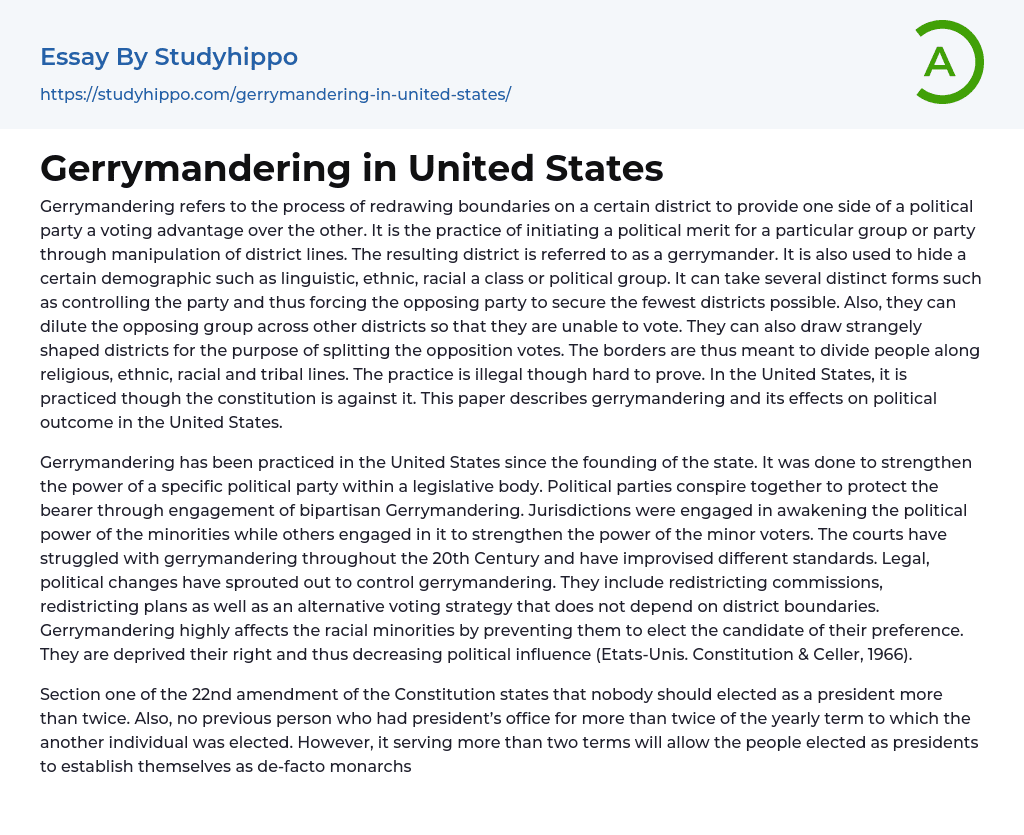Gerrymandering is the act of redrawing district boundaries in order to give an unfair advantage to a particular political party or group.
The intention behind the creation of a gerrymander district is to conceal or manipulate a specific demographic, be it related to language, ethnicity, race, class, or politics. Various strategies are employed to achieve this objective. One method is to obtain dominance over the governing party and decrease the number of districts allocated to the opposing party. Another approach entails dispersing members of the opposition across multiple districts with the purpose of diminishing their voting impact. Additionally, peculiarly shaped districts can be devised in order to divide and weaken votes from opposing factions.
The objective of borders is to separate individuals according to their religious, ethnic, racial, and tribal backgrounds—a behavior that is deemed unlawful. Nonetheless, despite being unconstitutional, gerr
...ymandering remains widespread in the United States. This article explores the effects of gerrymandering on political results within the country and highlights its existence since the establishment of the nation.
Gerrymandering is a political strategy used to increase the influence of a particular political party in a legislative body. This strategy involves bipartisan cooperation to protect their own interests. Some jurisdictions use gerrymandering to enhance the power of minority groups, while others use it to strengthen the voting power of minority voters. Throughout the 20th Century, courts have dealt with gerrymandering and established different criteria for assessing it. Consequently, legal and political changes have been made, including the creation of redistricting commissions and alternative voting methods that do not rely on district boundaries.
The influence of gerrymandering on racial minorities is substantial as it hinders their ability to vot
for their preferred candidate, thereby reducing their political impact (Etats-Unis. Constitution & Celler, 1966). According to the initial part of the 22nd amendment in the Constitution, no person can be elected president more than two times. Additionally, individuals who have served as president for over two terms may potentially wield authority akin to de-facto monarchs.
"There is a concern that Roosevelt's four election victories may allow people to undermine the well-known democratic legacy, preventing others with leadership abilities from reaching the presidency and ultimately leading to a dictatorship (Grofman, 2007). The court utilizes judicial review to analyze whether a treaty, statute, or administrative action violates the current laws outlined in the U.S Constitution. Decisions made by the U.S Supreme Court hold significant constitutional authority, requiring the court to engage in reviewing the judicial process for examining claims."
After the examination, the court concluded that the carriage act would be deemed constitutional. This marked the beginning of the Supreme Court's role in hearing cases and asserting judicial authority. Chief Justice John Marshall upheld the court's responsibilities. The legislation that was found unconstitutional was overturned due to its consequences. Bipartisan gerrymandering refers to redistricting that benefits both political parties, primarily within the two-party system of the United States.
Since the year 2000, it has become a common practice that the most noncompetitive redistricting strategies in the United States (Etats-Unis. Constitution & Celler, 1966) are constitutional. This means that Americans are well represented by the two party systems (bipartisan) under the equal protection clause. Therefore, it is evident that gerrymandering only offers limited opportunities to influence political outcomes.
Partisan gerrymandering aims to secure more positions by redirecting one party, resulting in
short-term benefits. However, the impact tends to diminish as significant shifts in the executives occur. In the event of such shifts, the gerrymandering party can use it to redraw districts. They employ the tactic of creating oddly-shaped districts to divide opposition votes. Nonetheless, partisan gerrymandering has detrimental effects on polarization. Its main objective is not to enhance safety but rather to gain a stronghold.
Bipartisan gerrymandering results in polarization by endeavoring to satisfy both factions within each party, necessitating participation from both minority and majority districts. However, these consequences are confined to specific communities, and it is evident that judicial review has been incorporated into the U.S. Constitution.
Both the proponent and opponent of this review do not require any mechanism to prevent the enforcement of laws that disrupt the constitution at this level. The act of gerrymandering disperses these opposing groups among different districts, resulting in a loss of voting power for both sides.
References
- Etats-Unis. Constitution., & In Celler, E. (1966). The Constitution of the United States of America. Washington: United States Government Printing Office.
- Grofman, B. (2007). Political Gerrymandering and the Courts.
New York: Algora Pub.
The publication was done by Algora Pub in New York.
- Bill Of Rights essays
- Civil Liberties essays
- First Amendment To The United States Constitution essays
- Fourth Amendment To The United States Constitution essays
- Second amendment essays
- Agreement essays
- Business Law essays
- Common Law essays
- Community Policing essays
- Constitution essays
- Consumer Protection essays
- Contract essays
- Contract Law essays
- Copyright Infringement essays
- Court essays
- Crime essays
- Criminal Law essays
- Employment Law essays
- Family Law essays
- Injustice essays
- Judge essays
- Jury essays
- Justice essays
- Lawsuit essays
- Lawyer essays
- Marijuana Legalization essays
- Ownership essays
- Police essays
- Property essays
- Protection essays
- Security essays
- Tort Law essays
- Treaty essays
- United States Constitution essays
- War on Drugs essays




